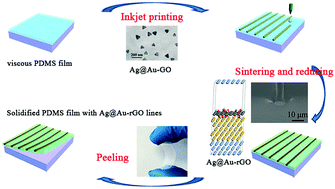Transparent Ag@Au–graphene patterns with conductive stability via inkjet printing†
Abstract
A patterned electrode film with ultrahigh conductive stability and transparency is obtained via inkjet printing based on a kind of high-stability conductive ink and a viscoelastic state substrate. The Ag@Au nanotriangle platelets and graphene oxide hybrid (Ag@Au NTPs–GO) nanomaterial ink was synthesized. Then, it is inkjet-printed on the specific viscoelastic state base to improve the accuracy of patterns, and a flexible and transparent conductive film with Ag@Au nanotriangle platelets and reduced graphene oxide hybrid (Ag@Au NTPs–rGO) patterns was obtained after reduction. The patterns show no undesirable coffee ring effects, and the inkjet-printed rGO-based lines with ∼7 μm width and a film with high transparency (∼98%)are achieved. Meanwhile, the structure models of Ag–rGO and Ag@Au–rGO are built and calculated. It is found that the addition of a thin layer of Au coated on the surface of Ag can effectively reduce the surface energy of the Ag–reduced graphene oxide material and improve the stability of the material's conductivity. These enhancements of the printed film benefit from the core@shell structured nanomaterial, the viscoelastic state substrate and the high resolution patterns. This facile strategy will be significant for highly stable integrated circuit boards and highly transparent devices.



 Please wait while we load your content...
Please wait while we load your content...